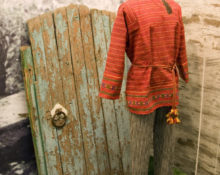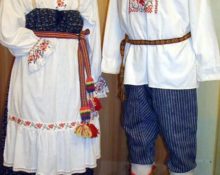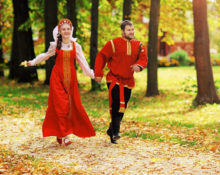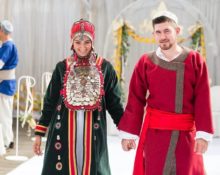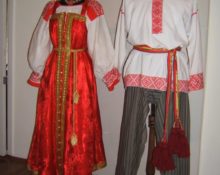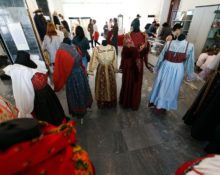Festive clothing in Rus' has always been distinguished by bright colors and intricate decorations. The most beautiful outfits were sewn for the wedding. On this turning point in her life, the bride changed two suits, and the groom walked to the altar in a shirt embroidered by his future wife. Moscow province is the richest in the country. What the bride’s wedding dress consisted of and what the groom wore to the celebration, read about it further.
Features of a wedding costume from the ancient Moscow region
Women's Russian wedding attire consisted of a shirt, sarafan, dushegreya, men's – of a shirt and ports. Costumes for every day and for holidays consisted of the same elements. Wedding clothes differed from them in decoration: they were richly embroidered with ornaments depicting leaves, flowers, berries, birds. The outfits were very bright colors, often a combination of a red shirt and a red or blue sundress, and the presence of yellow, gold, white, and blue splashes in elements of clothing or headdress, in chest decorations gave the newlyweds a particularly solemn appearance.
Elements of women's costume
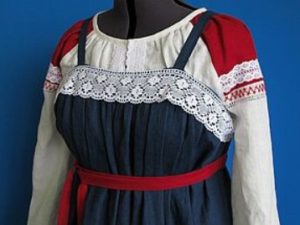 The shirt for the celebration was rectangular, with long sleeves. It gathered around the neck, and the gathers were secured with narrow embroidered or colored trim. The shirt was originally red, which symbolized joy and happiness, but blue, yellow, green and white fabric could also be used for this.
The shirt for the celebration was rectangular, with long sleeves. It gathered around the neck, and the gathers were secured with narrow embroidered or colored trim. The shirt was originally red, which symbolized joy and happiness, but blue, yellow, green and white fabric could also be used for this.
A ponyova was put on the shirt, fastened around the waist with a cord - an ancient prototype of a skirt. The sundress that replaced it existed in two types: a slanted Sayan, swinging or sewn in front, and a straight cut with straps, which in the Moscow province was called round, and outside its borders - Moscow. It was made from Chinese fabric - thick cotton or silk material brought by merchants from the East. The color scheme is black, blue, and more often red. A warmer was worn over a shirt and sundress; in some districts they preferred a padded warmer or a fur coat.
In the off-season they wore outerwear - a cloth overcoat, in winter - a sheepskin sheepskin coat. Depending on the wealth of the bride’s parents, it was covered with fabric or left uncovered, and wealthy peasants, merchants, and townspeople could afford to buy a hare fur coat for their daughter, covered with expensive Chinese material.
Important! By the end of the 19th – beginning of the 20th century, among the Russian peoples in cities, factory towns, and large villages, the folk wedding costume began to be replaced by calico dresses and couple suits: a long skirt and a blouse with a peplum.
Brides decorated themselves with pearl and glass beads, which were hung in several rows, put on a monisto, and added icons and crosses to it. A mandatory element of the wedding attire were large pearl or turquoise drop earrings and a braid., which was attached to the spit at the very bottom. The outfits were embroidered with braided weaving, multi-colored or silver braid with patterns and ornaments, and embroidered with colored and gold threads. Tin buttons also served as decoration.
Details of the groom's suit
The men walked to the altar in a straight, untucked shirt, knee-length, belted with a woven sash. The hem, sleeves and collars were decorated with embroidery or braid with ornaments. The shirt was complemented by dark blue pinstriped pants - trousers made from homemade cloth. The groom's suit was complemented by a black homespun caftan or a sheepskin coat, covered on top with a black or white caftan for less wear.
Shoes and hats in a wedding look
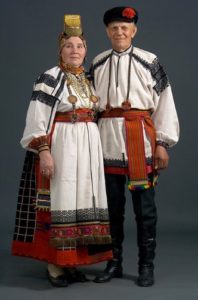 Poor peasants wore bast shoes, feet or pistons both on holidays and at weddings. In the Moscow district, which was richer than the rest, they bought cowhide or chrome boots for guys, and girls got married in cats - ancient shoes with low heels. Outfits consisting of a dress or skirt with a jacket were complemented by goatskin boots with high lace-up tops.
Poor peasants wore bast shoes, feet or pistons both on holidays and at weddings. In the Moscow district, which was richer than the rest, they bought cowhide or chrome boots for guys, and girls got married in cats - ancient shoes with low heels. Outfits consisting of a dress or skirt with a jacket were complemented by goatskin boots with high lace-up tops.
The bride's headdress consisted of a kokoshnik with a long thin coverlet - a veil. This is one of the most important and significant parts of the outfit.. The kokoshnik was embroidered with stones, pearls, beads, bugles, and gimp. The veil was a rectangular piece of thin purchased fabric, silk or calico, with gold or multi-colored embroidery, which covered the bride’s head over the kokoshnik.Wealthy families could buy a veil-kanavat for their daughter, an expensive and fabulously beautiful thing, while the poorest peasants were content with a purchased holiday veil as a veil.
On a special summer day, the guy put on a round hat with a ribbon wrapped around the crown - a sinner or cap, and in winter he covered his head with a warm sheepskin hat. Both the hat and the cap, in addition to a multi-colored ribbon, were decorated with a flower or a modest bouquet on the side.
Interesting facts about ancient wedding costumes of the Moscow province
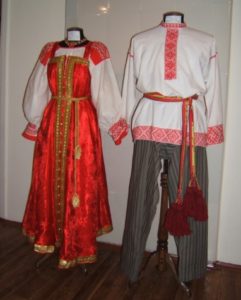 In ancient times, it was believed that a girl who gets married “dies” to her life in her parents’ home, since she goes to live with her husband’s family. The wedding attire consisted of pre-wedding and post-wedding. To church, the bride wore modest, mourning clothes and a veil. In the Moscow province, the pre-wedding attire was dominated by white, and after returning from church the attire was changed to bright, red clothes, lavishly decorated and demonstrating the level of well-being of related families.
In ancient times, it was believed that a girl who gets married “dies” to her life in her parents’ home, since she goes to live with her husband’s family. The wedding attire consisted of pre-wedding and post-wedding. To church, the bride wore modest, mourning clothes and a veil. In the Moscow province, the pre-wedding attire was dominated by white, and after returning from church the attire was changed to bright, red clothes, lavishly decorated and demonstrating the level of well-being of related families.
Immediately after the wedding, the girl’s friends unraveled her braid and braided it into two, placing them around her head. The braid was removed from the hair; now there was no need for it. The kokoshnik was replaced by another, which covered the entire head completely, and a veil was attached to it.


 0
0